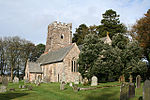Stoke Pero Church
Grade II* listed buildings in West SomersetGrade II* listed churches in Somerset

Stoke Pero Church in Stoke Pero, Somerset, England was built in the 13th century. It is a Grade II* listed building. Standing 1,013 feet (309 meters) above sea level, it is the highest church on Exmoor.
Excerpt from the Wikipedia article Stoke Pero Church (License: CC BY-SA 3.0, Authors, Images).Stoke Pero Church
Dicky's Path,
Geographical coordinates (GPS) Address Nearby Places Show on map
Geographical coordinates (GPS)
| Latitude | Longitude |
|---|---|
| N 51.1797 ° | E -3.6061 ° |
Address
Dicky's Path
TA24 8JT , Luccombe
England, United Kingdom
Open on Google Maps







